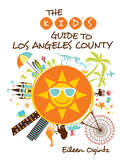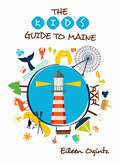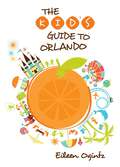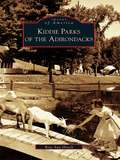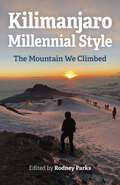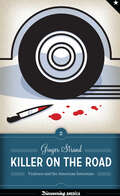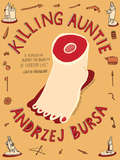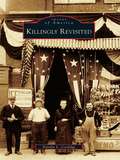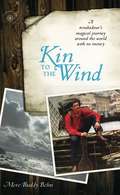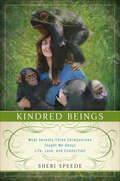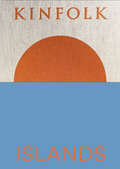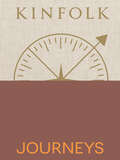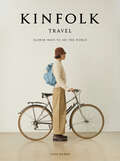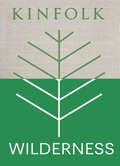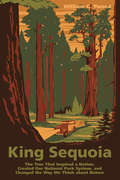- Table View
- List View
Kid's Guide to Los Angeles County (Kid's Guides Series)
by Eileen OgintzBefore you plan your family&’s next excursion in Southern California, get some help from a travel professional… and your kids! The Kid&’s Guide to Southern California lets the kids help plan the trip and guides you as you explore the region. Inside you&’ll find kid-tested tips on where to go, where to eat, what to see, and where to get the best souvenirs. Along the way, your kids will be engaged by reading and sharing fun California facts and cool travel tips. Awesome games and quizzes will keep the family entertained.
Kid's Guide to Maine
by Eileen OgintzBefore you plan your family&’s next vacation to Maine, get some help from a travel professional… and your kids! The Kid&’s Guide to Maine lets the kids help plan your trip and guides you as you explore Vacationland from the southern beaches to the great north woods. Inside you&’ll find kid-tested tips on where to go, where to eat, what to see, and where to get the best souvenirs. Along the way, your kids will be engaged by reading and sharing fun facts and cool travel tips. Awesome games and quizzes will keep the family entertained, too. Fun for both visiting and local kids.
Kid's Guide to Orlando (Kid's Guides Series)
by Eileen OgintzThe Kid's Guide to Orlando is a guidebook FOR the kids! With the guide, you get kid-tested tips on where to go, where to eat, what to see, and where to get the best souvenirs. Along the way, your kids will be engaged by reading and sharing fun facts and cool tips about Orlando parks and attractions. And awesome games and quizzes keep the family entertained!
Kid's Guide to San Diego (Kid's Guides Series)
by Eileen OgintzBefore you plan your family’s next excursion, get some help from a travel professional… and your kids! Kid’s Guide to San Diego lets the kids help plan the trip and guides you as you explore this California destination. Inside you’ll find kid-tested tips on where to go, where to eat, what to see, and where to get the best souvenirs. Along the way, your kids will be engaged by reading and sharing fun facts and cool travel tips. Awesome games and quizzes will keep the family entertained. Fun for both visiting and local kids.
Kid's Guide to San Francisco (Kid's Guides Series)
by Eileen OgintzBefore you plan your family’s next excursion in San Francisco, California, get some help from a travel professional… and your kids! The Kid’s Guide to San Francisco lets the kids help plan the trip and guides you as you explore the city. Inside you’ll find kid-tested tips on where to go, where to eat, what to see, and where to get the best souvenirs. Along the way, your kids will be engaged by reading and sharing fun San Francisco facts and cool travel tips. Awesome games and quizzes will keep the family entertained.
Kiddie Parks of the Adirondacks
by Rose Ann HirschThe first kiddie parks in North America were born in the lush forests of the Adirondack Mountains in the 1950s. These parks brought to life the characters of beloved fairytales,legends, and nursery rhymes through live performers, animated figures, and themed mechanical rides. Kiddie Parks of the Adirondacks contains images of some of the Adirondacks' most popular kiddie parks: Storytown U.S.A., Enchanted Forest of the Adirondacks, the Land of Make Believe, Magic Forest, and Santa's Workshop. Each park is home to various fantasy-themed amusements built to accommodate children rather than adults. Four of the five parks are still in operation and continue to entertain new generations of children every year.
Kids Like Me
by Lisa AguirreLittle Chloe is excited to take a special trip with her father to visit her grandmother in Haiti. As she tells her friends about the upcoming trip, Chloe and her friends wonder what the kids in Haiti are like and whether they like to do the same things like jumping rope while singing, playing soccer, working math problems and singing at church. Chloe is happy to learn that the kids in Haiti are very similar to Chloe and her friends, and they like to do many of the same things. When she returns from the trip, Chloe is excited to tell her friends at home about the kids in Haiti.
Kieran Read - Straight 8: The Autobiography
by Kieran ReadSHORTLISTED FOR INTERNATIONAL AUTOBIOGRAPHY OF THE YEAR AT THE 2020 TELEGRAPH SPORTS BOOK AWARDS.As Kieran Read calls time on his distinguished New Zealand career at the end of the Rugby World Cup, this is the open and honest life story of one of rugby's greatest players, a legendary All Black and a two-time World Cup winner.Kieran Read first played for the All Blacks as a 23-year-old in 2008 and since then has amassed more than a century of Test appearances in the famous jersey. Now, after a stellar provincial, club and international career - including back-to-back World Cup victories - the New Zealand captain writes openly and honestly about his time in the game.Read takes to these pages with his trademark determination, lifting the lid on the unique pressures of succeeding as captain the most celebrated All Black of all time (Richie McCaw). He outlines the decisions that molded his career and uncovers the skills of the coaches who shaped him, while offering readers an inside account of how the world's greatest team functions and thrives.Read unpacks the emotional toll of injury and the ignominy of defeat, neatly illustrating the intense experience of representing a rugby-obsessed nation while delivering a masterclass in how to manage the many demands on the mind and on the body.Forthright and frank, Read's well-respected views on the game and its future are a must-read for rugby fans, and his take on the myriad personalities and the peccadilloes of his team-mates, coaches and opponents will be sure to surprise and delight. From the playing fields of Papakura to the summit of the sport, Read has faced every challenge head on. His life story if no exception.
Kieran Read - Straight 8: The Autobiography
by Kieran ReadSHORTLISTED FOR INTERNATIONAL AUTOBIOGRAPHY OF THE YEAR AT THE 2020 TELEGRAPH SPORTS BOOK AWARDS.As Kieran Read calls time on his distinguished New Zealand career at the end of the Rugby World Cup, this is the open and honest life story of one of rugby's greatest players, a legendary All Black and a two-time World Cup winner.Kieran Read first played for the All Blacks as a 23-year-old in 2008 and since then has amassed more than a century of Test appearances in the famous jersey. Now, after a stellar provincial, club and international career - including back-to-back World Cup victories - the New Zealand captain writes openly and honestly about his time in the game.Read takes to these pages with his trademark determination, lifting the lid on the unique pressures of succeeding as captain the most celebrated All Black of all time (Richie McCaw). He outlines the decisions that molded his career and uncovers the skills of the coaches who shaped him, while offering readers an inside account of how the world's greatest team functions and thrives.Read unpacks the emotional toll of injury and the ignominy of defeat, neatly illustrating the intense experience of representing a rugby-obsessed nation while delivering a masterclass in how to manage the many demands on the mind and on the body.Forthright and frank, Read's well-respected views on the game and its future are a must-read for rugby fans, and his take on the myriad personalities and the peccadilloes of his team-mates, coaches and opponents will be sure to surprise and delight. From the playing fields of Papakura to the summit of the sport, Read has faced every challenge head on. His life story if no exception.
Kieran Read - Straight 8: The Autobiography
by Kieran ReadSHORTLISTED FOR INTERNATIONAL AUTOBIOGRAPHY OF THE YEAR AT THE 2020 TELEGRAPH SPORTS BOOK AWARDS.As Kieran Read prepares to call time on his distinguished New Zealand career at the end of the Rugby World Cup, this is the open and honest life story of one of rugby's greatest players, a legendary All Black and a two-time World Cup winner.Kieran Read first played for the All Blacks as a 23-year-old in 2008 and since then has amassed more than a century of Test appearances in the famous jersey. Now, after a stellar provincial, club and international career - including back-to-back World Cup victories - the New Zealand captain writes openly and honestly about his time in the game.Read takes to these pages with his trademark determination, lifting the lid on the unique pressures of succeeding as captain the most celebrated All Black of all time (Richie McCaw). He outlines the decisions that molded his career and uncovers the skills of the coaches who shaped him, while offering readers an inside account of how the world's greatest team functions and thrives.Read unpacks the emotional toll of injury and the ignominy of defeat, neatly illustrating the intense experience of representing a rugby-obsessed nation while delivering a masterclass in how to manage the many demands on the mind and on the body.Forthright and frank, Read's well-respected views on the game and its future are a must-read for rugby fans, and his take on the myriad personalities and the peccadilloes of his team-mates, coaches and opponents will be sure to surprise and delight. From the playing fields of Papakura to the summit of the sport, Read has faced every challenge head on. His life story if no exception.
Kilimanjaro Millennial Style: The Mountain We Climbed
by Rodney Parks'As someone with no interest in adventure travel, I was surprised to find that I couldn't put this book down. The narrative is absorbing and engaging; the story is told with such authenticity that it captured my imagination the way a good novel would, leaving me eager to follow the students' journey and find out what would happen next. Despite being written by a variety of authors, the voice seemed very consistent and the book transitioned smoothly from one chapter to the next. I was completely caught up in the students' thoughts and emotions; I felt as though I was walking alongside them as they faced each challenge, getting to know them, and cheering them on to achieve their goal. I felt fortunate to benefit from the lessons they learned without having to leave the comfort of my warm, safe home. I enthusiastically recommend this book to anyone who might be contemplating a similar trip (or whose child has proposed such a trip) and also to anyone who loves to get lost in a fascinating, compelling, and well-told story.' Dr. Diane Miller, Director of Student Academic Services at the University of GeorgiaStudents in Elon University's first adventure-based learning course to Tanzania hiked to the top of Mt. Kilimanjaro - millennial style. Then they wrote a book about it. The 22 upper-level students in the Core Capstone course authored this book in order to share what they learned from their adventure, and provide helpful information for those who follow in their footsteps. Most travel adventure books about Kilimanjaro are written by older adults, and tend to focus on the individual's &“peak experience." Those reading Kilimanjaro, Millennial Style will quickly grasp the different ways young adults perceive their world, how their relationships are deepened, where they find adventure, and what it means to have an authentic experience together. As one of the authors wrote, "I would never want to hike to the top of Kilimanjaro again. Not because it wasn't the most amazing experience I have ever had, but because it wouldn't be with the people that made my experience so extraordinary."
Killer of Rome (Carbo of Rome)
by Alex GoughCarbo returns in an unputdownable novel of murder and mystery in ancient RomeAfter years of captivity and torture by German barbarians, former legionary Cicurinus’ ordeal should be over.Hearing of the legendary Carbo, he returns to Rome to seek out this hero who might help to bring him balance. Instead he finds Carbo descending into alcoholism and gambling, a broken man who brutally rebuffs him.Devastated and disgusted by the immoral city around him, Cicurinus, embarks on a rampage of slaughter through Rome’s poor and downtrodden. And to hide his tracks, he frames Carbo for the crimes.With everything at stake, can Carbo master his demons, clear his name, and stop the Killer of Rome?This latest from Alex Gough, a master of the genre, is a Roman thriller that you won’t be able to put down. Perfect for readers of Simon Scarrow, Conn Iggulden and Ben Kane.
Killer on the Road: Violence and the American Interstate (Discovering America #2)
by Ginger StrandStarting in the 1950s, Americans eagerly built the planet's largest public work: the 42,795-mile National System of Interstate and Defense Highways. Before the concrete was dry on the new roads, however, a specter began haunting them-the highway killer. He went by many names: the "Hitcher," the "Freeway Killer," the "Killer on the Road," the "I-5 Strangler," and the "Beltway Sniper. " Some of these criminals were imagined, but many were real. The nation's murder rate shot up as its expressways were built. America became more violent and more mobile at the same time. Killer on the Road tells the entwined stories of America's highways and its highway killers. There's the hot-rodding juvenile delinquent who led the National Guard on a multistate manhunt; the wannabe highway patrolman who murdered hitchhiking coeds; the record promoter who preyed on "ghetto kids" in a city reshaped by freeways; the nondescript married man who stalked the interstates seeking women with car trouble; and the trucker who delivered death with his cargo. Thudding away behind these grisly crime sprees is the story of the interstates-how they were sold, how they were built, how they reshaped the nation, and how we came to equate them with violence. Through the stories of highway killers, we see how the "killer on the road," like the train robber, the gangster, and the mobster, entered the cast of American outlaws, and how the freeway-conceived as a road to utopia-came to be feared as a highway to hell.
Killing Auntie
by Wiesiek Powaga Andrzej Bursa"The Polish postwar firebrand Andrzej Bursa acquired a reputation as a quick-burning, existentially tormented rebel. . . . Yet Bursa's dark humor and deadpan satire . . . keep utter bleakness at bay."-The Independent"A revolution against the banality of everyday life."-Gazeta KrakowskaA young university student named Jurek, with no particular ambitions or talents, is adrift. After his doting aunt asks him to perform a small chore, he decides to kill her for no good reason other than, perhaps, boredom. Killing Auntie follows Jurek as he seeks to dispose of the corpse-a task more difficult than one might imagine-and then falls in love with a girl he meets on a train. Can he tell her what he's done? Will that ruin everything?"I'm convinced-simply-that we are all guilty," says Jurek, and his adventures with nosy neighbors, false-toothed grandmothers, and love-making lynxes shed light on how an entire society becomes involved in the murder and disposal of dear old Auntie. This is a short comedic masterpiece combining elements of Fyodor Dostoevsky, Jean-Paul Sartre, Franz Kafka, and Joseph Heller, coming together in the end to produce an unforgettable tale of murder and-just maybe-redemption.Andrzej Bursa was born in 1934 in Krakow, Poland, and died twenty-five years later. In his brief lifetime he composed some of the most original Polish writing of the twentieth century. Killing Auntie is his only novel. His brilliant career and tragic early death established him as a cult figure among restless and disenchanted youth.
Killingly Revisited
by Natalie L. CoolidgeIn the first volume, Killingly revealed the initial manufacturing emphasis in the town's villages. Killingly Revisited illustrates how the town survived after losing most of the textile industry, as it moved South, by actively seeking diversified commercial businesses. Within these pages, the town's fascinating past is displayed as newly acquired vintage views are coupled with information recently uncovered from the Killingly Historical and Genealogical Society's newspaper archives and other reference materials. In celebration of 300 years asan incorporated Connecticut town, the society is sharing photographs of Killingly's mills, businesses, buildings, churches, schools, andcemeteries. There have been losses from devastating fires that changed the face of Main Street. New streets and roads were added as modes of transportation changed. There are also new views of citizens at work and play.
Kim Chi Eats the World: 75 Recipes Fit for a (Drag) Queen - A Cookbook
by Kim ChiKIM CHI is a sickening drag queen, fierce business mogul, and lifelong culinary connoisseur. Drawing inspiration from the many countries she has traveled to on tour, in her debut cookbook, the superstar brings you along on a trip around the world. Starting off in North America, you&’ll find good ol&’ Canadian Classic Poutine and tempting Birria Tortas from Mexico. The next stop is South America for the most delectable Brazilian Brigadeiro Cake. Then on to Europe for French Lemon Sole, Swiss Roasted Flour Soup, and Italian Warm Lemon Ricotta Dip. And finally, you&’ll find yourself in Asia, where you can enjoy a mouthwatering Bossam that rivals the best Korean restaurants, and an Indian Dal Tadka that will leave your kitchen smelling divine. Along the way, Kim spills the tea with personal stories of her favorite memories, expeditions, and every perfect bite. Kim Chi Eats the World highlights a curated list of her favorite dishes and provides her own tried-and-true, easy-to-follow recipes for each, all with a unique Kim Chi twist. Plus, vibrant, bold photography captures Kim&’s humongous personality on the page—she&’s a delicious diva. After you cook your way through these recipes, you&’ll be giving international realness without ever having to leave your house. Werk.
Kin to the Wind
by Moro Buddy BohnKin to the Wind is the memoir of Moro, a gifted virtuoso guitarist and composer, who first played (and wrote his first composition) when he was six and performed his first of many concerts when he was twelve. The book recounts his journeys as he traveled the world as a troubadour, using only his guitar performances as currency. This talented former member of the world-famous New Christy Minstrels played in over 50 countries-in royal palaces, African casbahs, and even on a British warship in trade for his passage across the Indian Ocean. Bedouin smugglers took him across the Arabian Desert in their camel caravan, listening to his music beneath desert stars. While he was in Bangkok giving a command performance for Their Majesties King Bhumibol and Queen Sirikit of Thailand, the U.S. military invited him to play for the troops at their jungle camps. And he became the first entertainer to perform for American forces in the Vietnam conflict. He was also the first entertainer to appear at Paul Newman's famous 1960s exclusive Hollywood discotheque, THE FACTORY, where he played nightly. He followed that with an engagement at Howard Hughes' CABARET ROOM in Las Vegas where Mr. Hughes personally came to hear him. An Italian duchess who found him performing with a street-dancing flamenco troupe of gypsies in 1961 assisted him in obtaining a visa for Algeria where he then toured-during the violent Seven Years' War-and S.A.O. terrorists captured and held him. He played for them, literally for his life, whereupon they gave him money and let him go. Moro's memoir is an account of life's magic, suffused with an almost childlike innocence in his pursuit of dreams and his belief in the goodness of people the world over.
Kind Hearts and Coriander: perfect for fans of THE LIST!
by April HardyPERFECT FOR FANS OF THE LIST AND THE I HEART SERIESA heartwarming romantic comedyOn her mum’s death, sous chef Polly Hanson learns she may be hotelier Charles Hetherin’s illegitimate daughter. She’s grown up watching her mother struggle and do without, and she’s furious. The Hetherins have it all, including fabulous Hetherin Hall country house hotel. Determined to discover whether or not Charles is her father, Polly’s mistaken for a job applicant and finds herself working as a waitress at the Hall. Getting to know what might be her family, she can’t help but start to fall in love with them and their quirky ways.Romance is the last thing on her mind. But she can’t deny the sparks flying between her and Oliver, the grumpy but gorgeous restaurant manager. However, it seems no one is quite who Polly thinks they are…
Kind Hearts and Coriander: perfect for fans of THE LIST!
by April HardyPERFECT FOR FANS OF THE LIST AND THE I HEART SERIESA heartwarming romantic comedyOn her mum’s death, sous chef Polly Hanson learns she may be hotelier Charles Hetherin’s illegitimate daughter. She’s grown up watching her mother struggle and do without, and she’s furious. The Hetherins have it all, including fabulous Hetherin Hall country house hotel. Determined to discover whether or not Charles is her father, Polly’s mistaken for a job applicant and finds herself working as a waitress at the Hall. Getting to know what might be her family, she can’t help but start to fall in love with them and their quirky ways.Romance is the last thing on her mind. But she can’t deny the sparks flying between her and Oliver, the grumpy but gorgeous restaurant manager. However, it seems no one is quite who Polly thinks they are…
Kindred Beings: What Seventy-Three Chimpanzees Taught Me About Life, Love, and Connection
by Sheri SpeedeEnter a world of tender friendships, staunch loyalties, violent jealousies—and enduring love.As a child, Sheri Speede knew that she wanted to advocate for animals in any way she could. But it was not until many years after veterinary school, when she was transporting a chimpanzee named Pierre away from a biomedical facility as part of her job as a conservation advocate in Cameroon, that Dr. Speede discovered her true calling. She began to search for land for a forest sanctuary for captive chimpanzees that were held on chains and in small cages at local hotels.Dr. Speede eventually founded the Sanaga-Yong Chimpanzee Rescue Center, a forested home for orphans of the illegal ape meat trade. One chim- panzee, Dorothy, was rescued by Dr. Speede and her colleagues from a bleak existence imprisoned on a chain and forged a deep friendship with her. Dr. Speede explains how chimpanzees, like humans, are capable of a broad spectrum of emotional behaviors—both hateful and loving. Dr. Speede also candidly reveals her own struggles as a stranger in a foreign culture trying to adjust to rural African village life. And she admits that unlike Dorothy, she was not always kind, gentle, and forgiving.Dorothy died of old age at the sanctuary, and a photograph of Dorothy's funeral, in which Dr. Speede cradled Dorothy's head while her family of chimpanzees mournfully viewed her body, went viral after being published in National Geographic. The world was surprised at the depth of the chimps' grief at the loss of their friend, but Dr. Speede was not. Through the chimps, she had come to understand the meaning of love, loyalty, and true connection.While this is a compelling story about the emotional complexity of the chimpanzees she rescued and befriended, it is also Dr. Speede's story. Major events in her personal life, including love affairs, dangerous run-ins with criminals, and the birth of her daughter, unfold as the development of her primate rescue center runs parallel to her own development. Ultimately, Kindred Beings is a story of profound resilience, of both the apes and the woman who loved them.
Kinfolk Islands (Kinfolk Adventures)
by John Burns&“Wanderlust inspiration.&”—GQ, The Best Gifts for Coworkers Join Kinfolk on a journey off the beaten track, to islands big and small, in this collection of eighteen new travel stories. Whether it&’s a tour of the otherworldly landscape of Socotra in Yemen or a hike into the old growth of a Japanese forest on Yakushima, each slow travel itinerary invites you to set sail at a pace that allows for true discovery and immersion. Filled with ideas and inspiration for where to escape, explore and unwind, Kinfolk Islands is full of vibrant photography, practical guidance and thoughtful reflections on why the idea of an island embodies so many of our travel fantasies. There are the charms of urban islands, including Montréal&’s beloved Mile End neighborhood. Truly unexpected destinations, like Hormuz, off the coast of Iran, with its psychedelic scenery and bohemian spirit. Italy&’s sun-soaked Ponza, perfect for languid afternoons. And of course some of the world&’s most beautiful beaches, from jungle-fringed Caribbean sands to rugged and remote Nordic shores. Believing that travel is as much a state of mind as an action or itinerary, Kinfolk celebrates a way of exploring our world that not only fosters thoughtful perspectives on the places we visit but also deepens our relationship with home once the journey is over.
Kinfolk Journeys
by John BurnsAn unforgettable journey to breathtaking destinations around the world. Venture beyond the familiar with Kinfolk Journeys, a celebration of inspiring and sustainable ways to travel slower and see the world anew. Take a subterranean tour of Tashkent, join a local mailman on his delivery route through rural New Zealand or sail the high seas en route to Antarctica—these stories will transform the way you travel, no matter the locale or distance. Kinfolk Journeys is filled with ideas for day trips, weekend breaks and grander adventures that center around slower modes of transport—road, rail, sea and trail—and encourage us to be our own guides along the way. Featuring lush photography, practical advice and thoughtful reflections on responsible travel, the eighteen stories in this collection take us to some of the world&’s most extraordinary landscapes, from Namibia&’s daring and desolate coastline to the most remote reaches of Australia. Guided by the belief that travel is as much a state of mind as an action or itinerary, Kinfolk Journeys is about exploring our world in a way that not only fosters thoughtful perspectives on the places we visit but also deepens our relationship with home once the journey is over.
Kinfolk Travel: Slower Ways to See the World (Kinfolk)
by John BurnsExplore the art of mindful travel with Kinfolk, the pioneers in &“slow living,&” their philosophy of simplicity, authenticity, intentionality and community. With nearly 450,000 copies in print, the Kinfolk series has applied this philosophy to entertaining (The Kinfolk Table), interior design (The Kinfolk Home), and living with nature (The Kinfolk Garden). Now they have turned their attention to &“slow travel,&” offering readers a road map for planning trips that foster meaningful connections with local people and authentic experiences of local culture. Go museum hopping in Tasmania, or birdwatching in London. Explore the burgeoning fashion community in Dakar. Take a bicycle tour through Idaho, or a train trip from Oslo to Bergen. Drawing on the magazine&’s global community of writers and photographers, Kinfolk Travel takes readers to over 20 location across five continents, with travel tips from locals, stunning images, and thoughtful essays.
Kinfolk Wilderness (Kinfolk Adventures)
by John BurnsThe second volume in the new Kinfolk trilogy (following Kinfolk Islands), which invites readers to celebrate the beauty and possibility to be found in the great outdoors.
King Sequoia: The Tree That Inspired a Nation, Created Our National Park System, and Changed the Way We Think about Nature (The Story Behind the Scenery Ser.)
by William TweedFrom a towering tree, one of California's preeminent naturalists unspools a history that echoes across generations and continents. Former park ranger William C. Tweed takes readers on a tour of the Big Trees in a narrative that travels deep into the Sierras, around the West, and all the way to New Zealand; and in doing so he explores the American public's evolving relationship with sequoias. It comes as no surprise that the groves in Yosemite and Calaveras were early tourist destinations, as this species that predated Christ and loomed over all the world's other trees was the embodiment of California's superlative, almost unbelievable appeal. When sequoias were threatened by logging interests, the feelings of horror that this desecration evoked in people catalyzed protection efforts; in a very direct way, this species inspired the Park Idea. And sequoias' influence doesn't end there: as science evolved to consider landscapes more holistically, sequoias were once again at the heart of this attitudinal shift. Featuring an entrancing cast of adventurers, researchers, politicians, and environmentalists, King Sequoia reveals how one tree species has transformed Americans' connection to the natural world.
